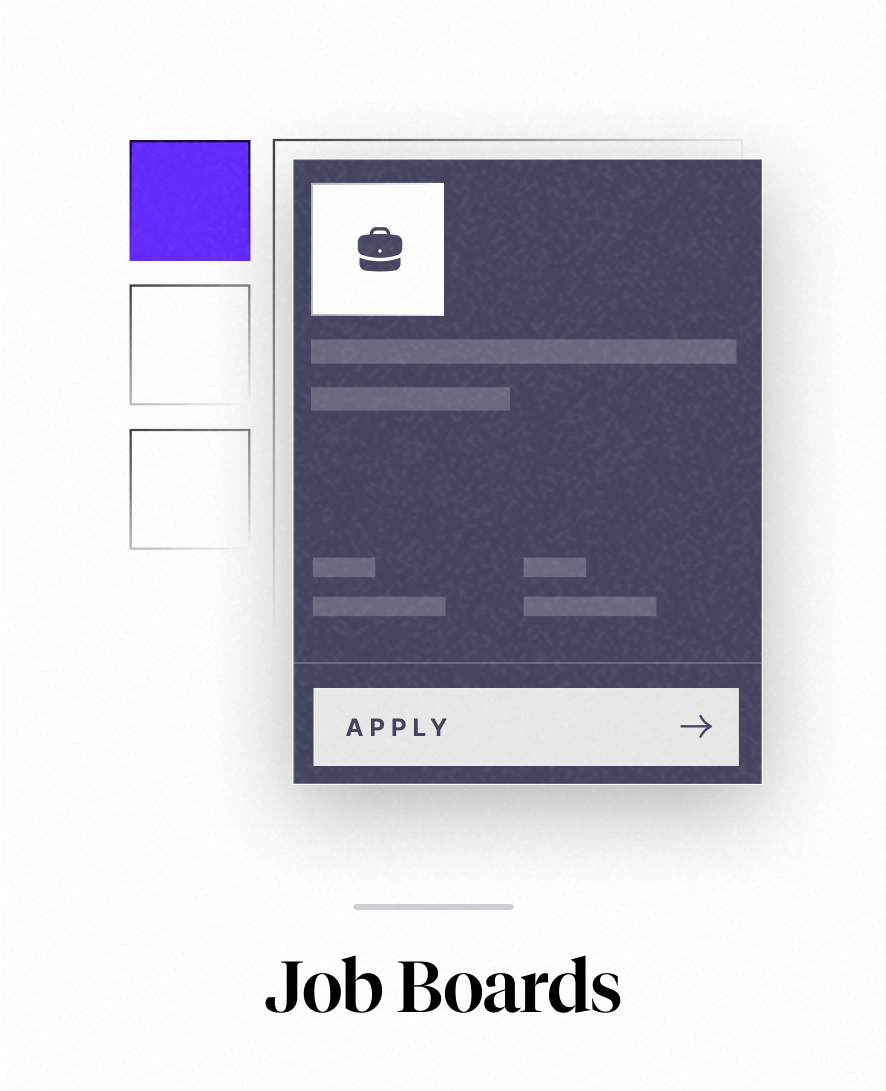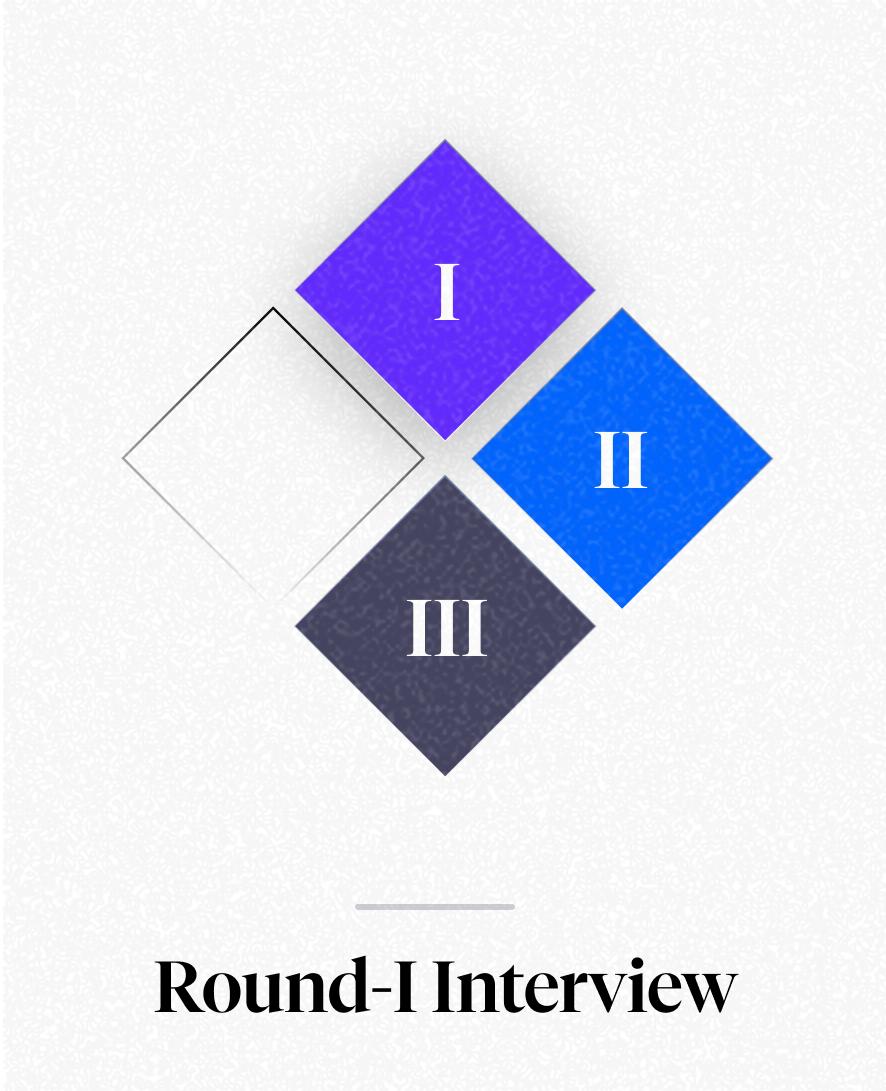Acquisition project | Notion
Elevator Pitch
Need to build a habit tracker to track your diet and workouts, but no idea where to start?
What if you could just select a template and start filling your tracker in <2minutes?
That’s what Notion does. It removes the friction to get your life (or work) together.
Notion is an all-in-one workspace that integrates notes, tasks, and collaboration to streamline your productivity.
What is Notion?
Notion is an all-in-one productivity and workspace tool developed by Notion Labs, Inc. Launched in 2016 and based in San Francisco, it serves as an all-in-one workspace where users can think, write, plan, and manage various tasks and projects.
Key Features
- Organizational Tool: Notion allows users to create notes, manage projects, and even run entire companies. It can function as a CRM, project management tool, or a collaborative workspace for teams.
- Customization: The platform is highly customizable, enabling users to design their workflows using various templates and building blocks. It supports different content types, including text, images, databases, and Kanban boards, making it adaptable for various use cases.
- Collaboration: Notion supports real-time collaboration, allowing multiple users to work on the same document simultaneously. It integrates with various tools like Google Drive, Slack, and Asana, enhancing its functionality for team projects.
- Notion AI: This feature uses artificial intelligence to assist users in generating content, summarizing notes, and automating tasks. It is an additional cost on top of the subscription fees.
- Cross-Platform Accessibility: Notion is available on multiple operating systems and can be accessed via web browsers, making it convenient for users to manage their work from anywhere.
Market Presence
Criteria | Description |
What is it? | All-in-one workspace productivity tool for docs, wiki and task management |
Founded | 2016 |
Form Factor | Web (Browser + desktop) and mobile apps (IOS and Android) |
Region(s) | Worldwide |
Value Proposition | All-in-one workspace productivity tool |
Understanding Core Value Proposition
Notion's core value proposition is centered around the idea of being an all-in-one workspace that integrates various productivity tools into a single platform. This allows users to streamline their workflows by combining note-taking, project management, and collaboration features without needing multiple separate applications.Key aspects of Notion's value proposition include:
- Comprehensive Functionality: Notion claims to be "all you need" for productivity, suggesting that it can replace several other tools, thereby simplifying the user experience and reducing the need for switching between apps.
- Customization and Flexibility: Users can tailor their Notion workspace to fit their specific needs, creating personalized dashboards and workflows that enhance productivity and organization.
- Collaboration: The platform facilitates real-time collaboration among team members, making it easier to work together on projects and share information seamlessly.
- User-Centric Design: Notion's interface is designed to be intuitive, allowing users to easily navigate and utilize its features without a steep learning curve.
An amazing thing is how simply Notion communicates its core value proposition through its landing page. From the first glance, as a user, you know what you'll get.
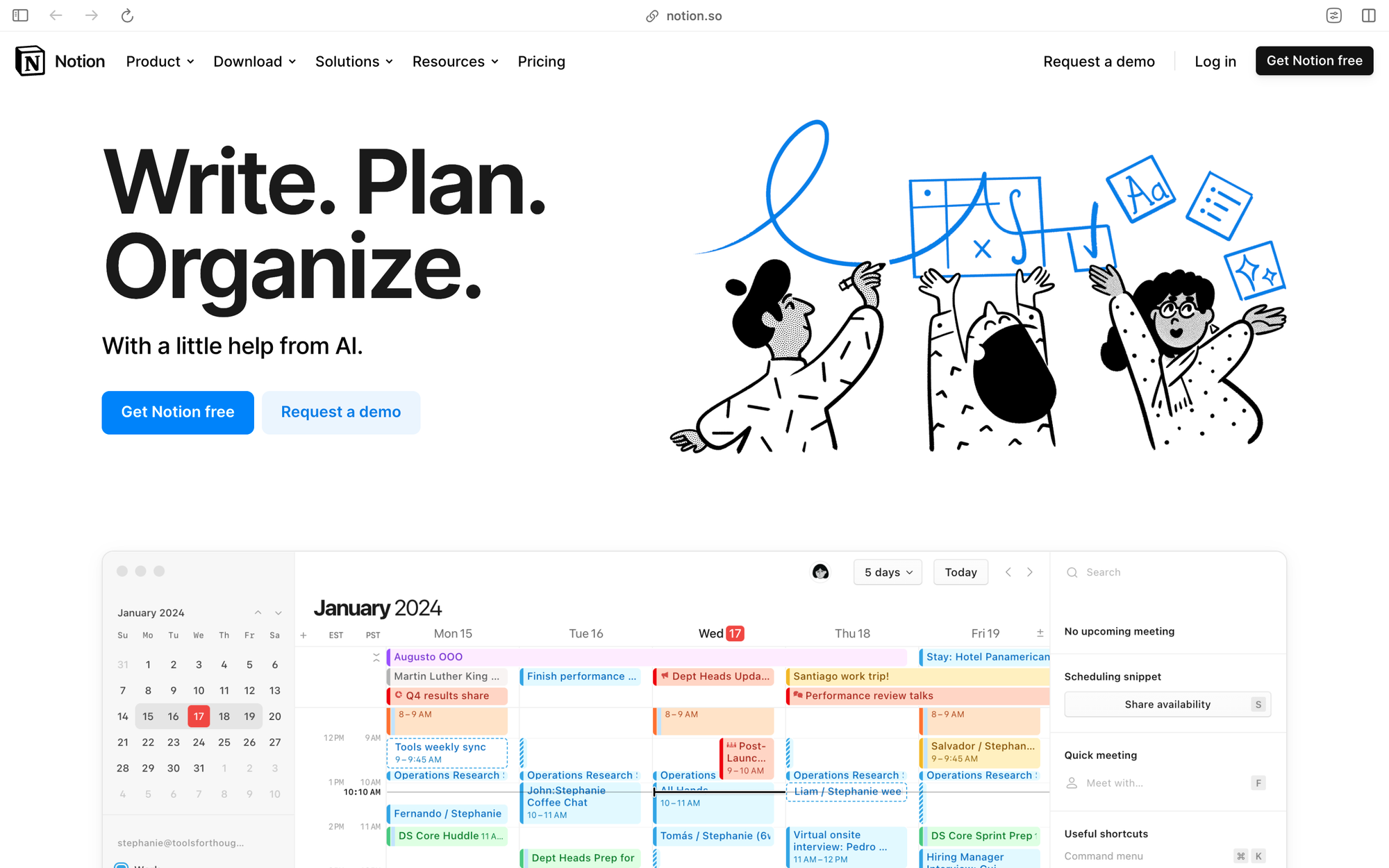
Why I picked notion
How I got to know about Notion's story:
I co-authored a piece on "How Notion Grows" early this year. During this time, I had the opportunity to interview a few employees and ex-employees of Notion and research about the company in-depth across the web.
After finding out all about Notion's origin story, how they got where they are and how they market their product, I got fascinated by not just the product but also of the company and the culture.
Since, the work I did on the piece has some research and aspects that can be used in this project, I thought it can be an interesting and different way to approach this project.
(Note: If you’re interested, you can check out the piece on Notion here. You will notice I took a few points around Notion’s existing acquisition channels from there. I assume and hope it’s alright since it’s my own work and research!)
Crazy Numbers and Going Head-to-Head with the Tech Giants
Today, based on their last released numbers, Notion is valued at $10B with over 30M total users and over 4M paying users, totalling to an ARR of ~$567 Million. It has won all over the productivity and docs market, competing with the giants- Google and Microsoft in different features such as docs, task management, databases and a lot more!
There are always some rough edges
While Notion has a fanbase that's as crazy as a cult, there are some people who while like the idea of Notion, get overwhelmed with it. The reasons are:
- Because of its empty canvas for each new page, it can be too confusing to know what to do.
- It is cluttered with too many features because of which, at times, discovery can become tricky
Understanding the Users
- I spoke to 10 users who used Notion either for personal use or work or both. The ICP based on my user interviews might be a little biased because the sample primarily consisted of GrowthX members.
- Apart from this, interviews with a few Notion employees and ex-employees early in the year. I have some data and research points from those that I have included in my ICP and Market understanding.
- Since, my research showcased both work and personal use. First, I’ll divide ICP in both B2C and B2B scenarios. Then, I’ll do a comparative analysis and select the ICP to proceed with for the selection and detailing of acquisition channels.
Understanding ICP
B2C Userbase
Criteria | ICP 1 |
Age | 25-30 |
Need | Docs, note-taking |
Pain Point | - Rigid tools for note-taking and personal docs - Poor text editor - Less to no customisation |
Solution | Flexibility, smart editor, templates |
Motivation | Get things done in a simple manner without too much effort on the tool and more focus on creativity + thinking |
Perceived Value of Brand | Simple to use, note-taking and documentation tool |
Marketing Pitch | All-in-one productivity tool |
Goals | Helps users stay productive by enabling them with: 1. note-taking 2. Maintaining to-do list |
Frequency of use case | Daily |
Average Spend on the product | |
B2B Userbase
Criteria | ICP1 |
Company Size | 100-500 |
Location | Worldwide |
Funding Raised | Seed, Series A, Series B |
Industry Domain | Tech / software product startups |
Stage of the company | Early scaling |
Organization Structure | Lean + flat hierarchy |
Decision Maker | Founder / Functional Heads |
Decision Blocker | Finance |
Frequency of use case | Daily |
Products / tools used in workplace | Figma, Notion, Miro, Canva, Google Workspace, Hubspot, Coda, Asana, Jira |
Organisational Goals | 1. PMF 2. Growth / Scale |
Preferred Outreach Channels | 1. LinkedIn 2. Email |
Motivation | Need for better collaboration, easy visibility and async communication |
Organization Influence | Employees - PMs / Devs |
Based on my research, I found that Notion’s user base is built in a way that its B2C user base indirectly leads to B2B user base as well. Due to this, I have thought of taking an ICP from each segment instead of 2 ICPs from one segment.
Criteria | B2C ICP | B2B ICP |
Adoption Curve | Medium | Medium |
Appetite to Pay | Low | Medium to high |
Frequency of Use Case | Medium | High |
Distribution Potential | Medium | High |
Understanding the Market
Notion competes in 5 different markets:
- Project Management
- Docs / Wikis
- Spreadsheets / Databases
- Note-taking
- Presentations
For this project, I’m taking its 3 largest markets:
- Docs
- Project management
- Note-taking
Factors | Google Docs / MS Word / Coda | Asana | Apple Notes |
What is the core problem being solved by them? | - Documentation | Task management | Note-taking |
What are the products/features/services being offered? | - Document creation - Collaboration | - Project Management - Templates - Collaboration | - Note-taking - Organisation of notes - Collaboration |
Who are the users? | Students, Working professionals, Writers and Editors | Freelancers, Students, Working professionals | Freelancers, Students, Working professionals |
GTM Strategy + channels used | 1. Annual keynotes 2. Social Media 3. Emails 4. Channel marketing 5. Youtube | 1. Email newsletters 2. social media 3. customer support relations 4. Youtube | 1. Annual keynotes 2. Social Media 3. Youtube |
What pricing model do they operate on? | - G docs: Freemium - MS word: included with windows OS + subscription for workspaces - Coda: Freemium | Freemium | Included with apple products |
How have they raised funding? | Google & MS: Public Company Coda: VC backed | Private: VC-backed by | Public Company |
Brand Positioning | - Documentation - Workspace | - Workspace - Project management - Task management | - Personal use: MacOS + iPhone for personal notes - Towards students: through ipad and apple pencil |
UX Evaluation | Google docs 7 MS word: Simple to use - traditional Coda: Modern UX design | Modern UX design | - Simple to use - Traditional design |
What is your product’s Right to Win? | - Modern UX - Templates - Flexibility - Multiple Usecases - Simple-to-use editor | - Multiple usecases - More flexibility - Simple-to-use editor | - Templates - Wider collaboration - Multiple usecases - Simple-to-use editor |
What can you learn from them? | - Scalability | - Ease of use | - Positioning / Marketing |
Notion is in a strong position to continue expanding its market share among competitors. It uniquely challenges industry giants like Microsoft, Google, and Apple, as well as newer entrants such as Asana, Atlassian, Evernote, and Coda.
Although Coda is its closest rival, Notion appears to be leading in this competition.
Consequently, Notion has the potential to grow significantly, potentially increasing its market presence by 100 times.
For context, Microsoft Office 365 alone generates over $70 billion in revenue, while Google Workspace brings in an additional $7 billion.
Notion Market:
ARPU = Total Revenue / Total number of users = 567,000,000 / 4000000 = $141.75 = ~$142
Let’s assume a few numbers here. Based on my search, the estimated number of knowledge workers is about 1.25 B. Assuming 60% could use a tool like Notion and also speaks English:
TAM = Total no. of potential customers x Average Revenue Per Customer (ARPU) = 1.25 B x 60% x $142 = $106.50 B = ~$106 B
SAM = TAM x Target Market Segment (percentage of the total market) = $106 B X 50% = $53 B
SOM = SAM x Market Penetration/Share = $53 B x 10% = ~$5.3 B
Note: These are based on certain assumptions so the actual number might be off.
Notion’s Acquisition Strategy
Notion is super big on Product-led Growth. It’s entire hyper growth is built on that. While still growing intensively, the company has reached a mature stage in terms of its impact, customer base, revenue and valuation.
Even the next stages of its journey seem to follow the same principles by doubling down on what has already worked for them.
Let’s dive deeper on these:
Integrations, integrations and integrations!
(Product Integrations)
A big acquisition tactic through its product is Notion’s ability to keep on adding integrations at a crazy pace.
Notion understands the challenge for teams to use different products simultaneously.
In case of some products, it is easier to offer an import option due to their similar functionalities. However, for products with different functionalities that are still vital to these teams, it's important to ensure that their workflows remain unaffected.
Notion introduced integrations and expanded them to a giant integrations gallery allowing users to connect their Notion account with various tools of different use-cases such as file management (google drive), design (Canva, Figma, etc), Customer experience (Zendesk) and many more.
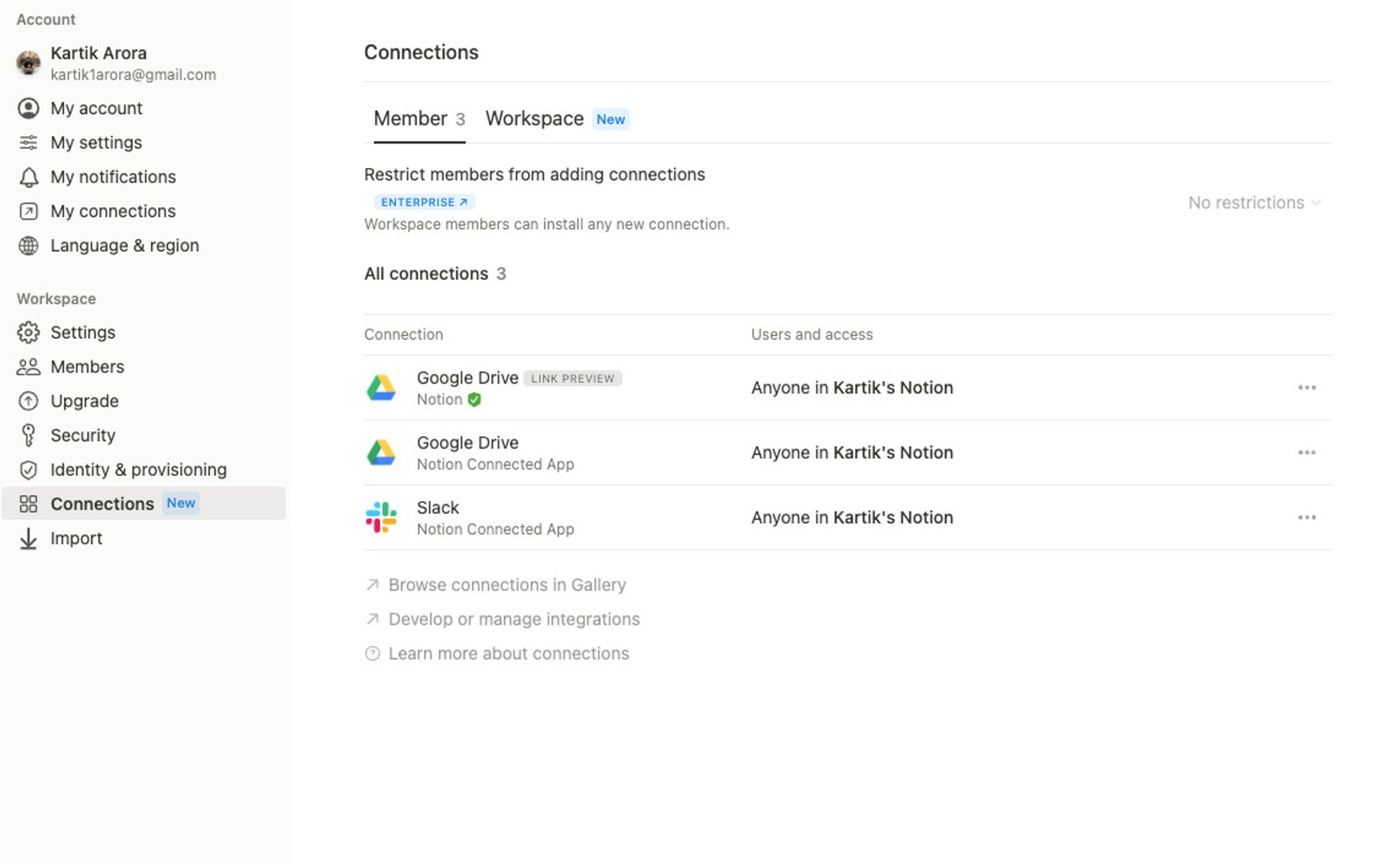
These integrations not only allow seamless collaboration but also keep the users on the product itself rather than going to different tools separately.
For example, as a PM, instead of opening Figma and then going to the relevant project, it’s so much easier to just open a Notion project in which the Figma file is already embedded.
That’s why even in 2023, Notion was shipping new embeds like Miro.
Community-Led Growth and Word of Mouth
(Content loops)
Notion’s biggest acquisition strategy isn’t organic, paid ads, referrals or even integrations. It’s actually their community and content loops (something they didn’t even plan for!)
Let’s take a look at how this works:
Notion’s community and word-of-mouth relies on 4 big things:
- High Guest limits
- Ease to publish a website
- Templates marketplace
- New content creators
Here’s its community and word-of-mouth flywheel: (forgive my poor handwriting)
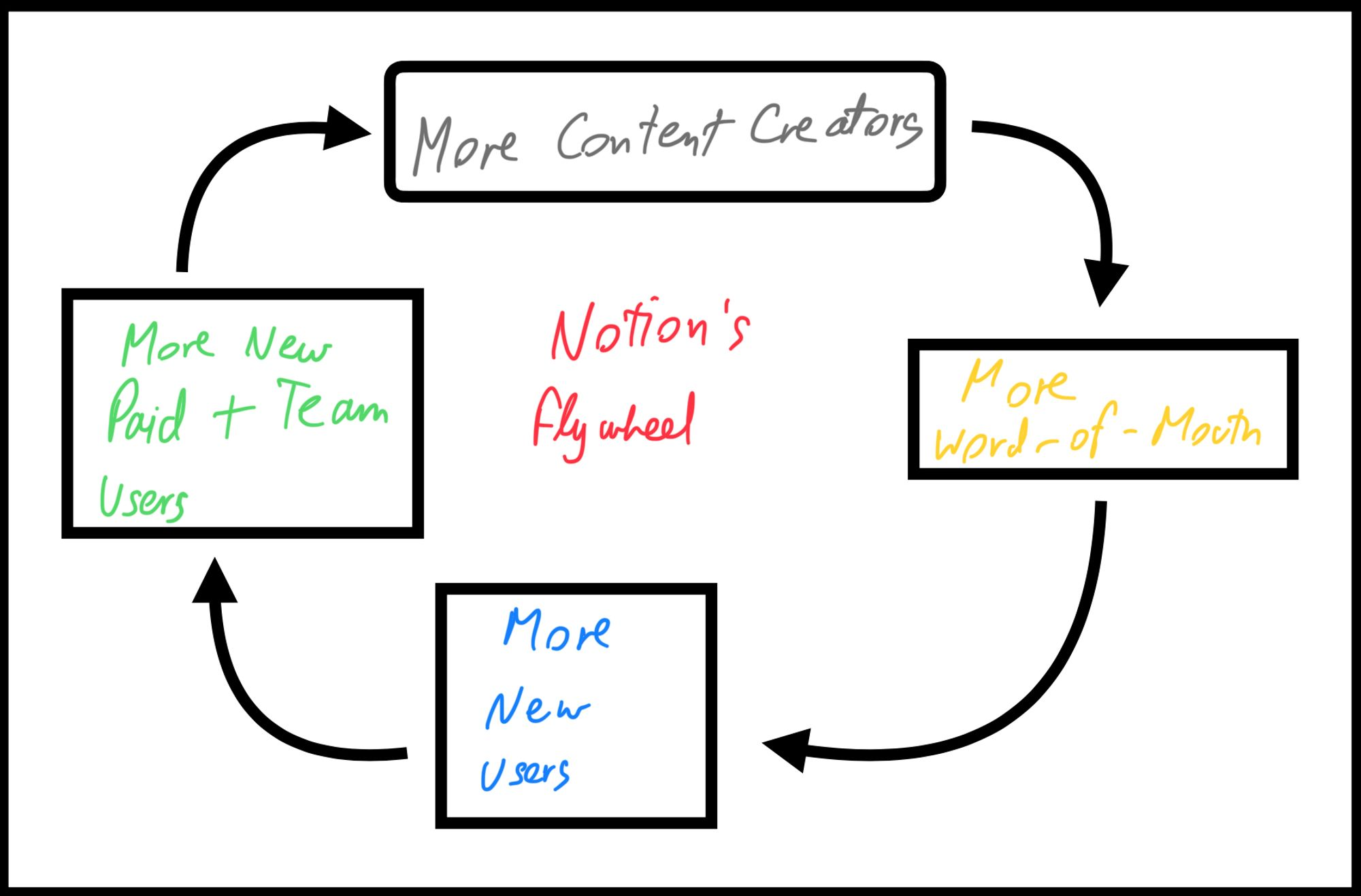
Let’s break down the elements that enable the above flywheel:
High guest limits
Notion workspaces beg to be invited to. To share any document, you have to share Notion.
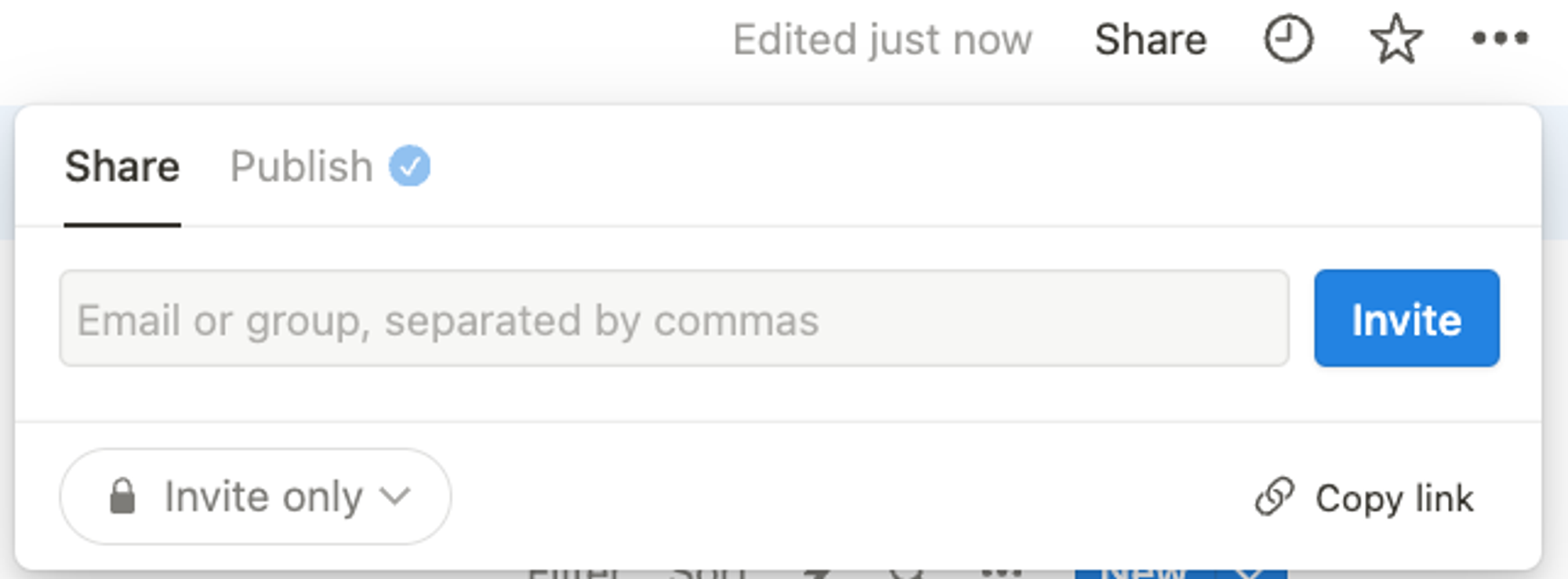
Notion’s guest limits are very high. Up to 10 for a free plan.
This means that free users can invite up to 10 friends to experience how great Notion is.
And Notion actually does get a lot of invites out of free users.
Ease to publish a website
In the social media era, websites can get a bad rap but in this industry, websites can do wonders. Notion, from the start, has been focused on allowing individuals to publish beautiful ones.
It’s just one-click. Notion even hosts it for you:
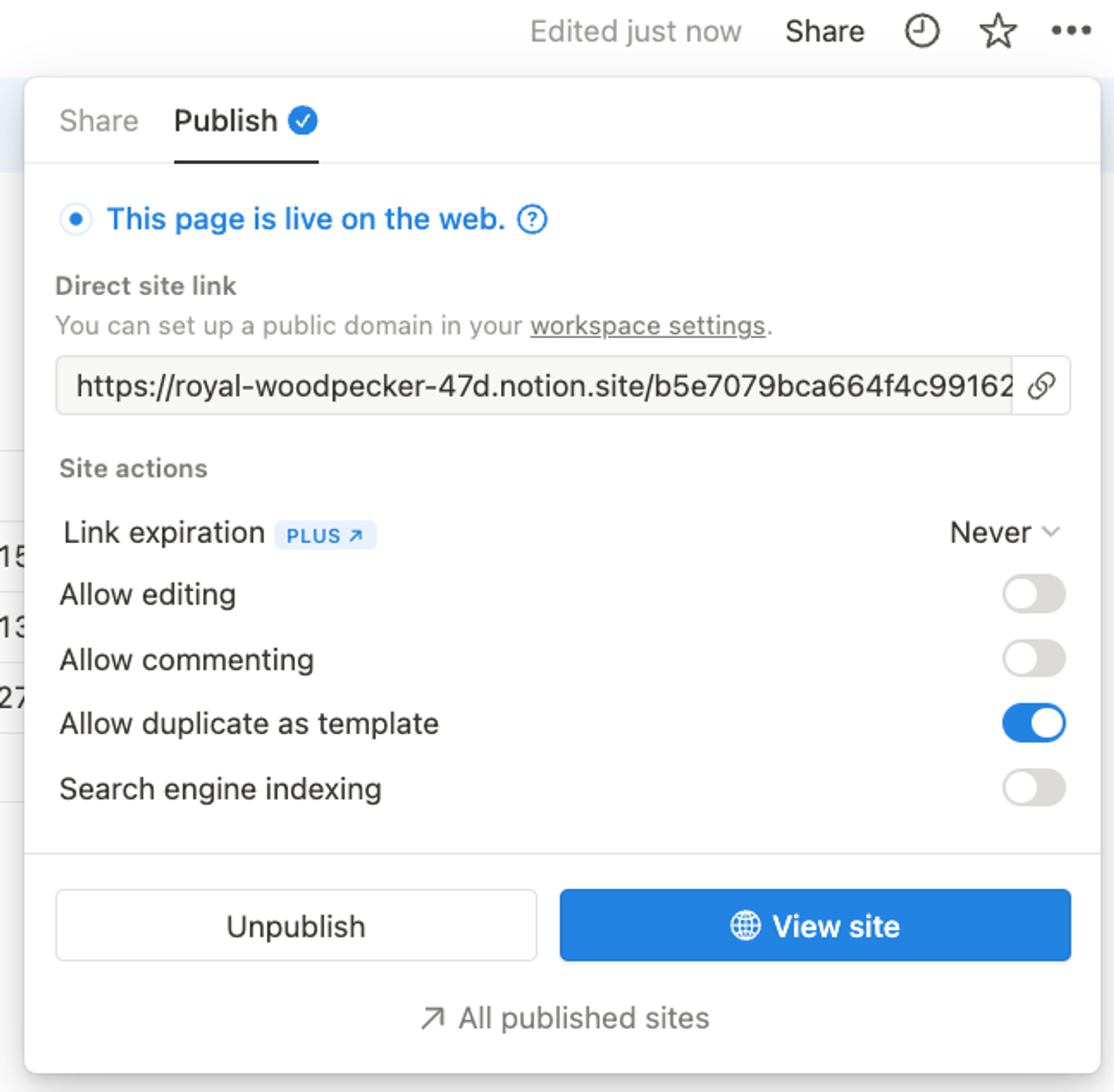
It's incredibly easy to publish a website with Notion.
This feature originated from a personal challenge that CEO Ivan Zhao faced after graduating college. He often helped friends create simple design websites but found the lack of a visual design tool frustrating.
Notion solved this issue by allowing users to effortlessly turn documents into websites. This functionality is widely utilized by creators to share documents or databases.
The potential for website publishing with Notion is vast.
Notion has effectively leveraged one of the web's oldest mediums as a growth channel.
Templates marketplace
Notion started with a handful of default templates that covered a variety of use cases in different work functions.
But it really took off when users of it started to do all sorts of powerful things with them:
- Budget Tracking System
- Daily journaling + task tracker
- Creating automations for businesses
- Creating Standard Operating Procedures for employees
Notion turned each template into a new "app" by using its many tools. This makes Notion very different from Google Workspace and Office 365. Unlike Notion, they don't have lots of users creating and sharing their own apps. This enables Notion to create an ecosystem like no other.
New Content Creators
The unique part of Notion’s templates is its content creators.
There’s now an entire segment of influencers just focused on Notion content.
(This is also connected to their affiliate program, more on it below!)
Two examples are Thomas Frank and Easlo.
Thomas Frank
Thomas Frank is a YouTuber who has ~3 million subscribers, who uses a separate channel creating content around Notion.
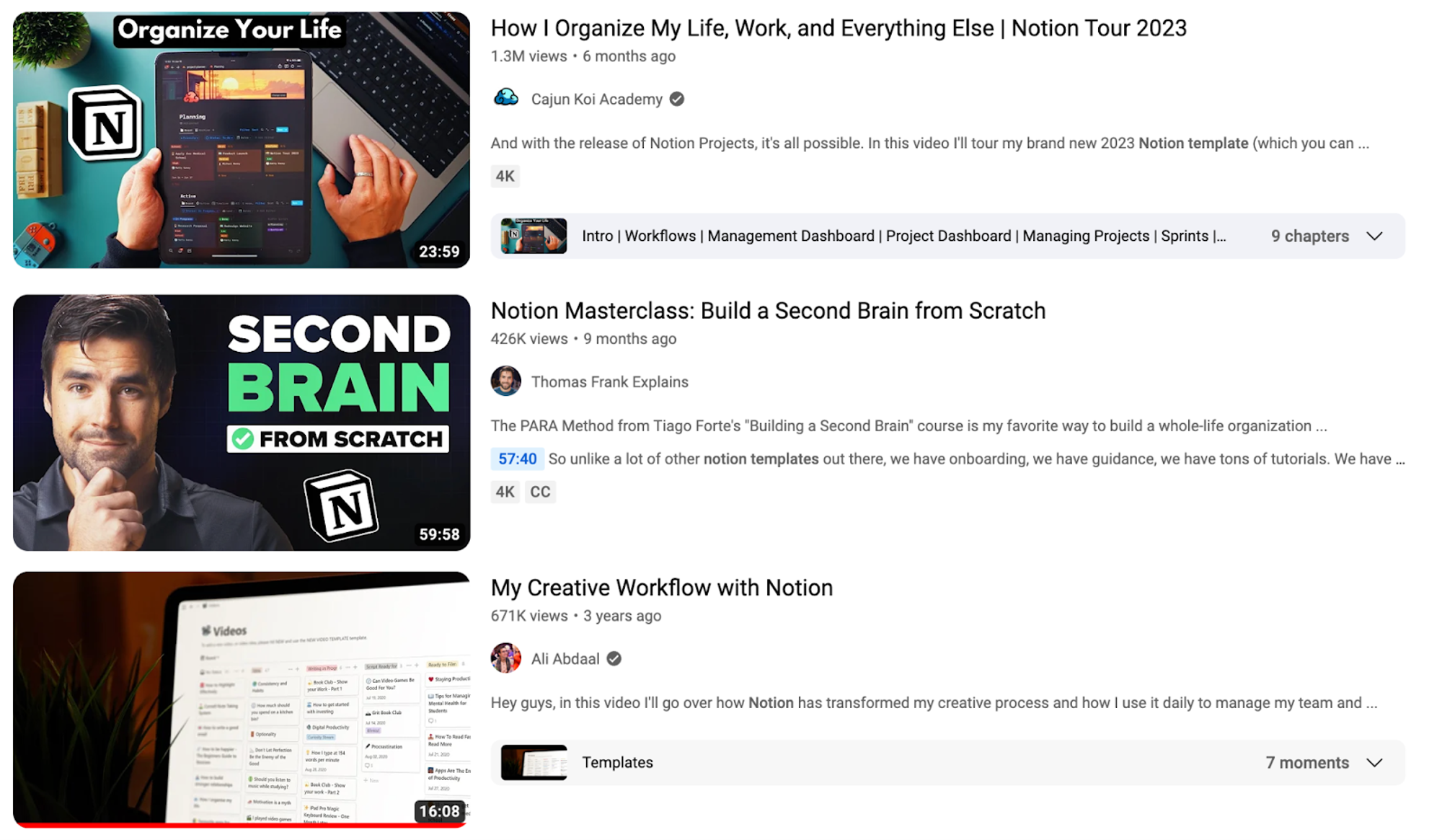
Easlo
Easlo is a content creator who has over 400,000 followers on TikTok and 350,000 followers on X.
He creates highly designed content about personal and business life.
In these, he often uses Notion to organize his thoughts and plans.
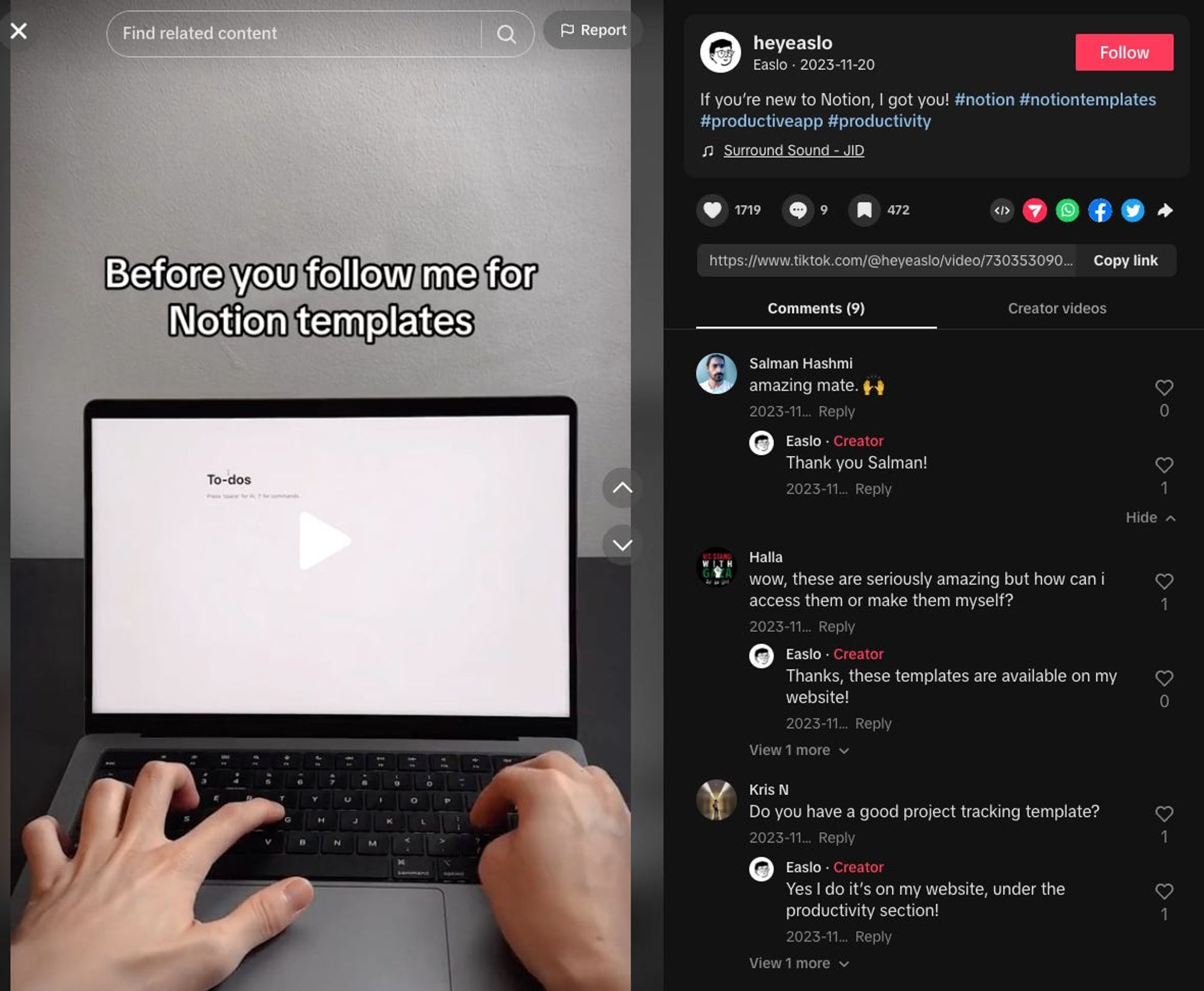
He's making over $200K per year selling templates on the platform.
One of the employees mentioned that top creators on the platform make over $1M per year.
By being able to sell their templates to their audience, creators profit being in the Notion ecosystem.
This has helped to create a thriving community of Notion content creators that is unlike almost any B2B SaaS product out there right now.
Referrals and Partnerships
Notion Affiliate Program
Notion has an affiliate program which is pretty straight forward as stated in the images below.
It has a symbiotic relation with its content loops in a way that both work hand-in-hand and end up being a strong flywheel (already attached above).
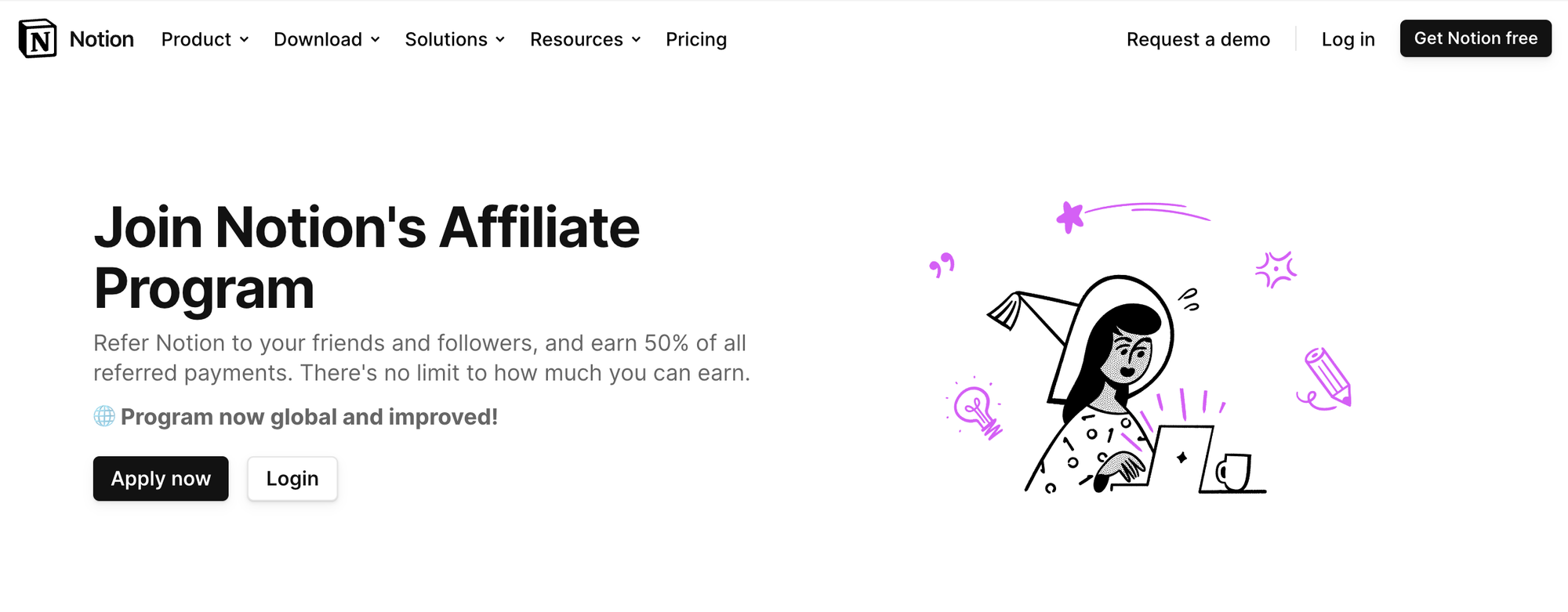
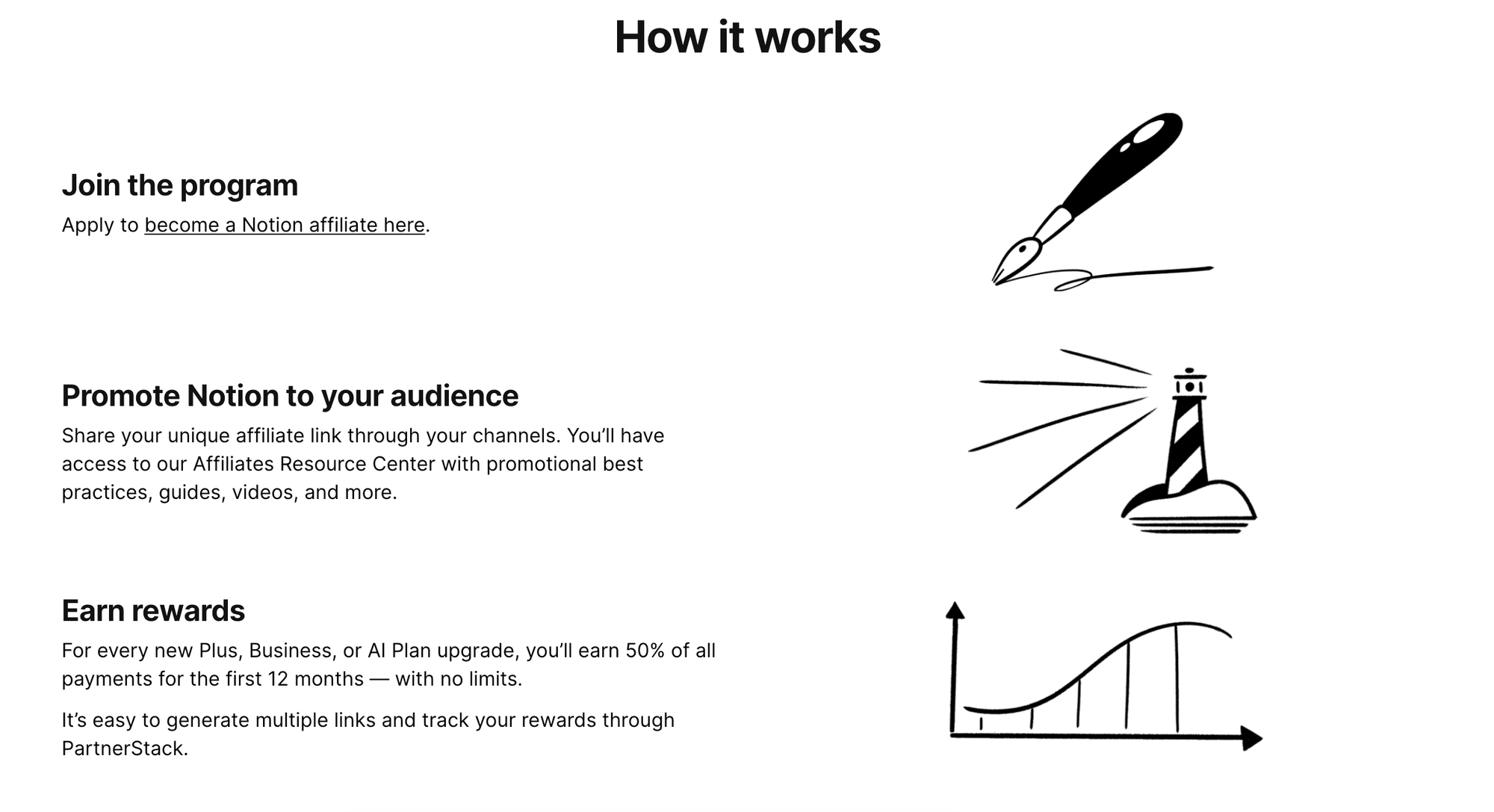
Detailing Acquisition Experiments
Product Integration
Integration Virtual Meetings and Event Platforms (e.g., Zoom, Airmeet, Hopin)
Objective: Scale customer acquisition volume
Overview
I have recently worked on some virtual event products and observed their AI capabilities. But these products can be a bit costly for small companies. So, I thought of integrating Notion with virtual event platforms like Hopin, Airmeet, or Zoom Events, where post event summaries can be recorded, along with insights and visuals.
Recently launched Notion AI and Notion Charts influenced me to think of these solutions as well.
Integration Idea:
Post-Event Summary and Action Item Creation
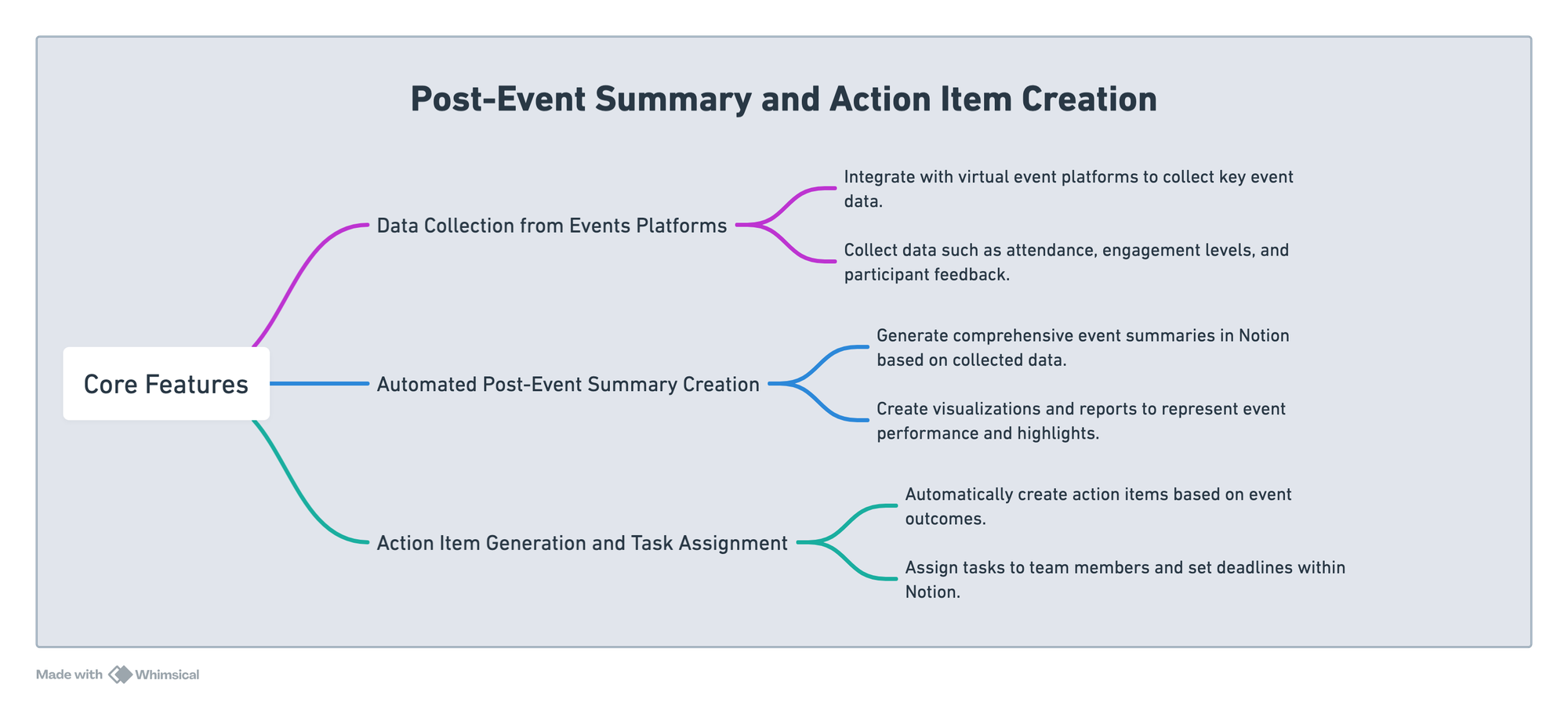
Core Features
- Data Collection from Event Platforms
- Integrate with virtual event platforms to collect key event data.
- Collect data such as attendance, engagement levels, and participant feedback.
- Automated Post-Event Summary Creation
- Generate comprehensive event summaries in Notion based on collected data (Notion AI).
- Create visualizations (Newly launched Notion Charts) and reports to represent event performance and highlights.
- Action Item Generation and Task Assignment
- Automatically create action items based on event outcomes.
- Assign tasks to team members and set deadlines within Notion.
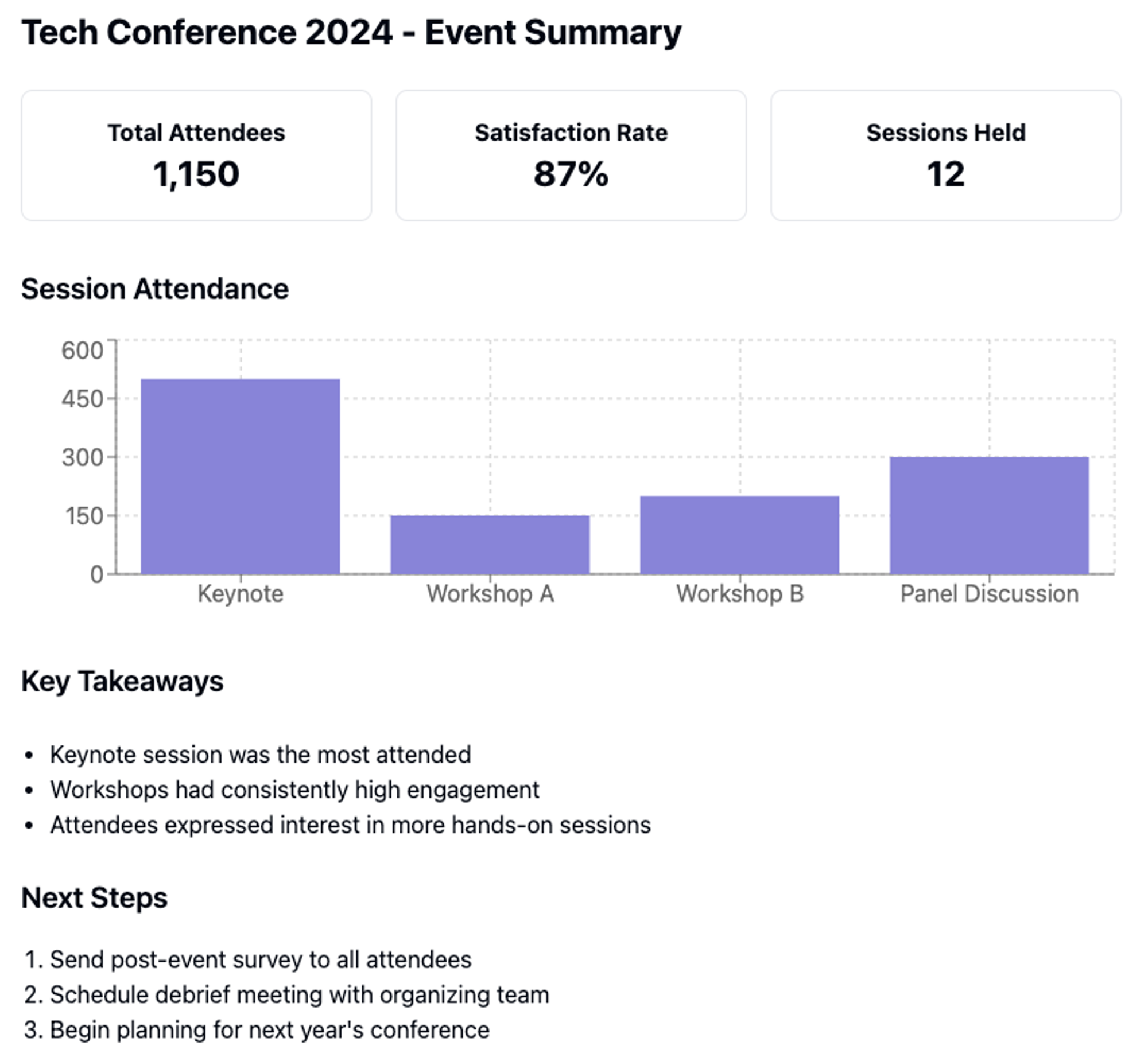
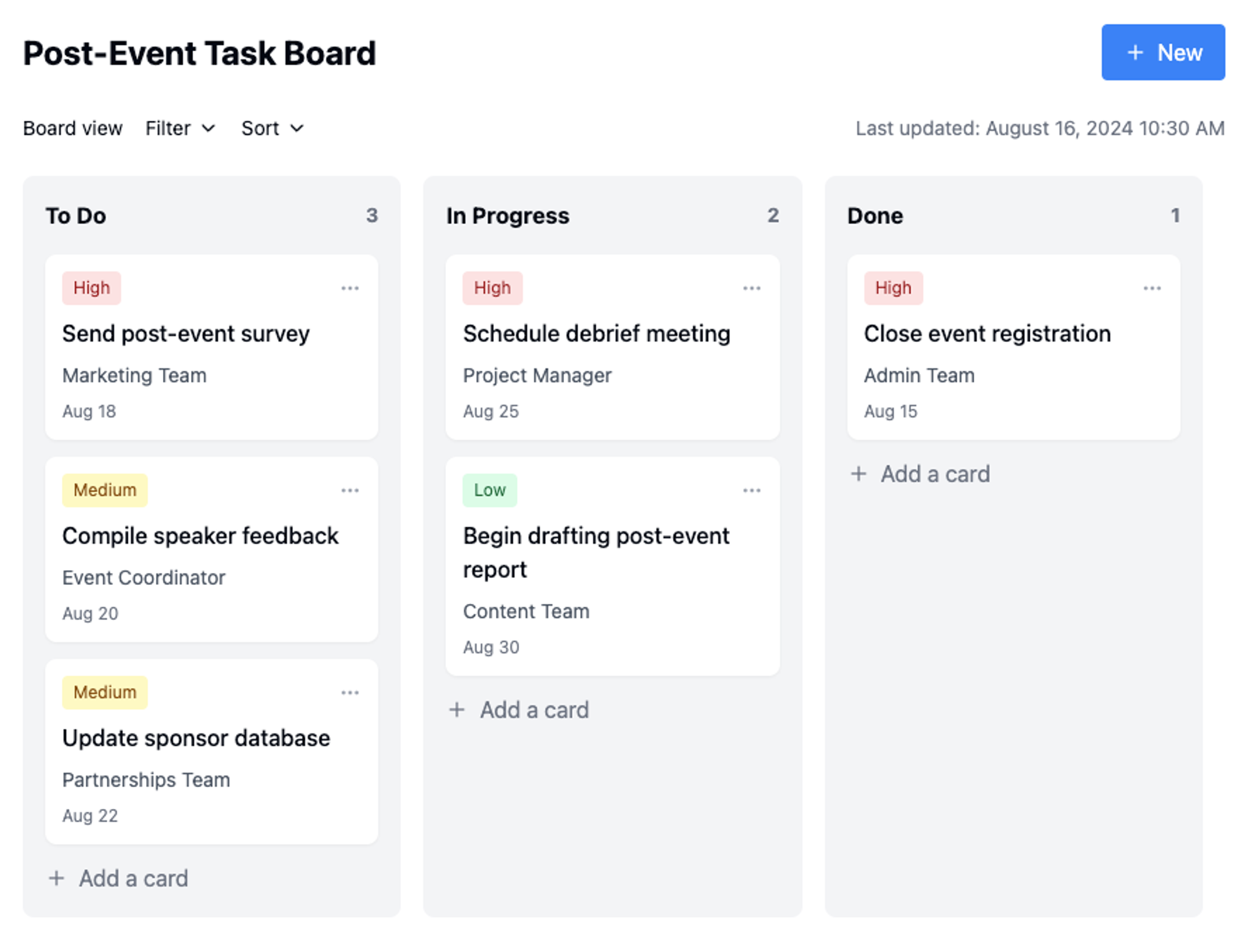
Technical Implementation (Thanks to tech for growth craft!)
- API Integration
- Develop API connections with major virtual event platforms.
- Ensure secure and efficient data transfer.
- Data Processing Engine
- Create logic to analyze event data and extract meaningful insights.
- Use Notion AI to summarize textual feedback.
- Notion Template System
- Design flexible Notion templates for event summaries and action item tracking.
- Ensure templates are flexible to fit various event types and organizational needs.
- Automation Scripts
- Develop scripts to automatically populate Notion templates with processed data.
- Create backend notion AI prompt for action item generation based on event outcomes.
User Experience
- For Event Organizers
- Simple setup process to connect virtual event platform with Notion.
- One-click generation of post-event Notion pages.
- For Team Members
- Receive notifications for assigned action items in Notion. (Should be straightforward since it’s a built-in Notion feature)
Integration Workflow
- Pre-Event Setup
- Event organizer connects virtual event platform to Notion.
- Organizer selects Notion template for summaries and action items.
- During Event
- System continuously collects data from the virtual event platform.
- Post-Event Processing
- System triggers automated data analysis and summary creation.
- Notion populates selected templates with event data and insights.
- Action items are generated and assigned based on predefined criteria.
- Review and Follow-up
- Event team reviews generated summaries and action items in Notion.
- Team collaborates on follow-up tasks within the Notion workspace.
User Acquisition Strategy
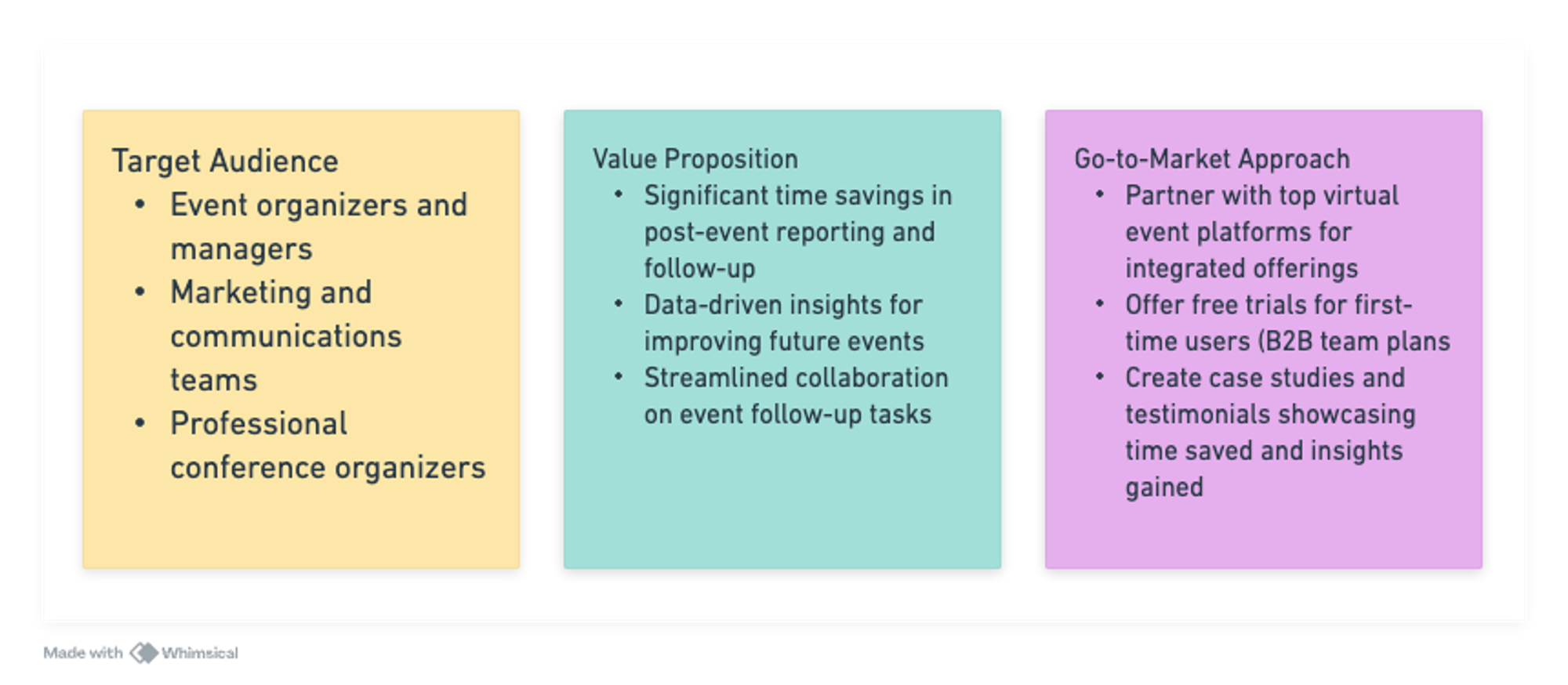
- Target Audience
- Event organizers and managers
- Marketing and communications teams
- Professional conference organizers
- Value Proposition - resonate around simpler project management, documentation and reporting
- Significant time savings in post-event reporting and follow-up
- Data-driven insights for improving future events
- Streamlined collaboration on event follow-up tasks
- Go-to-Market Approach
- Partner with top virtual event platforms for integrated offerings
- Offer free trials for first-time users (B2B team plans)
- Create case studies and testimonials showcasing time saved and insights gained
Evaluation
Variable | Value | Rationale |
Cost | Medium | API development and data processing capabilities required |
Flexibility | High | Can adapt to various event types, sizes and platforms |
Effort | Medium | Since mostly it’s a synchronous data integration along with mostly open APIs, shouldn’t require too much effort |
Speed | High | Can be developed and launched relatively quickly |
Scale | High | Potential to serve a wide range of event sizes and types |
Budget | Medium | Main investment will be in development and partnerships |
Success Metrics
- Number of events processed through the integration
- Time saved in post-event reporting (compared to manual methods)
- NPS - Net Promoter Score
- Retention rate of users for subsequent events
- Expansion of usage within organizations (e.g., from one team to multiple teams)
- In other words, increase or change in plan size
Referral Program/Partner Program + Content Loop
Affiliate, word-of-mouth and content loops have been so big for Notion that they haven’t had to spend a lot on Paid Ads. I would double down and try to run experiments to increase distribution from this channel itself.
Multi-tier Affiliate Program
I would try to run a hypothesis of different tiers of affiliate programs. Currently Notion has a single tier where they provide 50% of earnings from the new users through affiliate to the creators.
Objective: Scale customer acquisition volume
Let’s go into the detail of this multi-tier affiliate program:
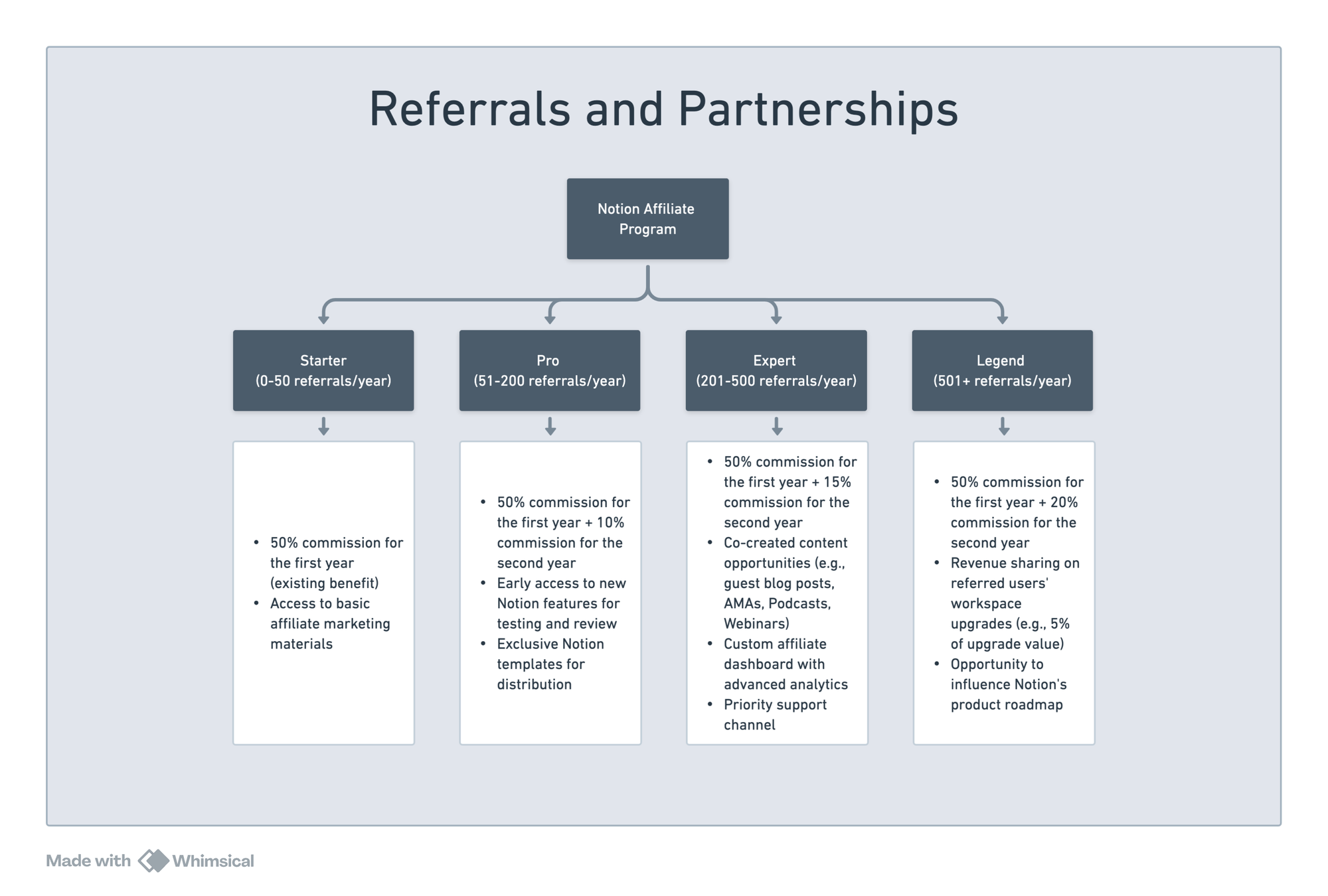
Tier Structure:
- Starter (0-50 referrals/year)
- Pro (51-200 referrals/year)
- Expert (201-500 referrals/year)
- Legend (501+ referrals/year)
Reward Structure:
Starter Tier:
- 50% commission for the first year (existing benefit)
- Access to basic affiliate marketing materials
Pro Tier:
- 50% commission for the first year + 10% commission for the second year
- Early access to new Notion features for testing and review
- Exclusive Notion templates for distribution
Expert Tier:
- 50% commission for the first year + 15% commission for the second year
- Co-created content opportunities (e.g., guest blog posts, AMAs, Podcasts, Webinars)
- Custom affiliate dashboard with advanced analytics
- Priority support channel
Legend Tier:
- 50% commission for the first year + 20% commission for the second year
- Revenue sharing on referred users' workspace upgrades (e.g., 5% of upgrade value)
- Opportunity to influence Notion's product roadmap
Additional Incentives:
- Quarterly Bonus: Top performer in each tier gets an extra 5% commission on all referrals for the next quarter
- Milestone Rewards: One-time bonuses for reaching certain lifetime referral milestones (e.g., 1000, 5000, 10000 referrals)
- Educational Stipend: Annual stipend for courses or conferences related to productivity, to be used for creating better Notion-related content
Evaluation:
Variable | Value | Rationale |
Cost | Medium | Additional costs for second-year commissions and bonuses, offset by increased referrals |
Flexibility | High | Diverse rewards cater to different motivations |
Effort | Medium | Requires updating systems for tracking and new tiers system |
Speed | Medium | Can be implemented relatively quickly, building on existing program |
Scale | High | Built to encourage and reward continued growth |
Budget | Medium | Increased rewards balanced by potential for larger referrals |
- Adding more tiers while maintaining the attractive 50% first-year commission might enable more people to start building content for their niche and earn from it. This can increase the intensity of Notion’s community flywheel.
- The second-year commissions and additional benefits encourage long-term commitment and higher-quality promotions.
- This has potential to improve the already working flywheel even more:
- More content creators > more word-of-mouth > more free users > more paid and team users
(Notion link for the project)
Brand focused courses
Great brands aren't built on clicks. They're built on trust. Craft narratives that resonate, campaigns that stand out, and brands that last.
All courses
Master every lever of growth — from acquisition to retention, data to events. Pick a course, go deep, and apply it to your business right away.
Explore courses by GrowthX
Built by Leaders From Amazon, CRED, Zepto, Hindustan Unilever, Flipkart, paytm & more
Course
Advanced Growth Strategy
Core principles to distribution, user onboarding, retention & monetisation.
58 modules
21 hours
Course
Go to Market
Learn to implement lean, balanced & all out GTM strategies while getting stakeholder buy-in.
17 modules
1 hour
Course
Brand Led Growth
Design your brand wedge & implement it across every customer touchpoint.
15 modules
2 hours
Course
Event Led Growth
Design an end to end strategy to create events that drive revenue growth.
48 modules
1 hour
Course
Growth Model Design
Learn how to break down your North Star metric into actionable input levers and prioritise them.
9 modules
1 hour
Course
Building Growth Teams
Learn how to design your team blueprint, attract, hire & retain great talent
24 modules
1 hour
Course
Data Led Growth
Learn the science of RCA & experimentation design to drive real revenue impact.
12 modules
2 hours
Course
Email marketing
Learn how to set up email as a channel and build the 0 → 1 strategy for email marketing
12 modules
1 hour
Course
Partnership Led Growth
Design product integrations & channel partnerships to drive revenue impact.
27 modules
1 hour
Course
Tech for Growth
Learn to ship better products with engineering & take informed trade-offs.
14 modules
2 hours
Crack a new job or a promotion with ELEVATE
Designed for mid-senior & leadership roles across growth, product, marketing, strategy & business
Learning Resources
Browse 500+ case studies, articles & resources the learning resources that you won't find on the internet.
Patience—you’re about to be impressed.











